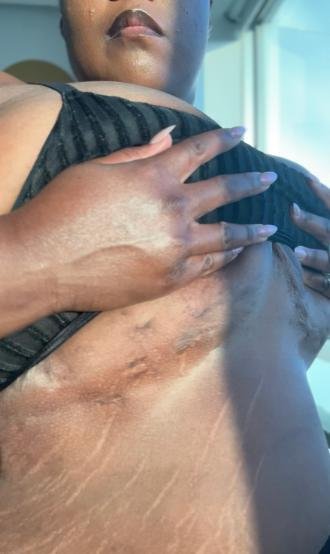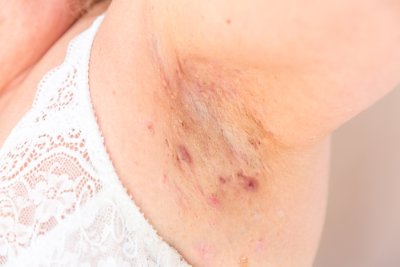Hidradenitis suppurativa (HS)
Hidradenitis suppurativa (HS) is an autoinflammatory skin condition that attacks hair follicles, causing painful recurring lumps and scarring of the skin.

Image: HS below the breasts (Photo: Jasmine Ivanna Espy)
About hidradenitis suppurativa
Hidradenitis suppurativa (HS), also known as acne inversa, is a chronic, inflammatory disease that often begins after puberty.
HS is characterized by painful boils-like lumps, deep follicular nodules, abscesses, and wounds and commonly occurs in the armpits, groin and inframammary folds (areas of skin-to-skin contact).
THE SEVERITY varies from person to person. Some experience mild symptoms in a few areas, while others have moderate to severe symptoms in multiple areas of the body.
THE DIAGNOSIS is made by a doctor based on the patient's medical history and a clinical examination of the skin. It can be challenging to make the correct diagnosis early in the course of the disease, so unfortunately, it may take a long time to receive the correct diagnosis.
What cause HS?
The exact mechanism of HS is unknown, but it likely involves immunological, hormonal, genetic, and other factors that influence disease development and progression (1).
Smoking and obesity are both strongly associated with hidradenitis suppurativa, and if you're obese and/or smoke it will make your symptoms worse.
HS is not caused by an infection, poor hygiene, and is not contagious!
Symptoms and Localization
THE CONDITION TENDS TO START with blackheads, spots filled with pus and firm pea-sized lumps that develop in one place. The lumps will either disappear or rupture and leak pus after a few hours or days. The lumps most commonly occur in the armpits, around the groin and genitals, on the buttocks and around the anus, or below the breasts. HS often causes pain, foul-smelling secretions, and scarring, which can significantly impact the patient's life.
Some of the lumps may become infected with bacteria, causing a secondary infection that will need to be treated with antibiotics.

Image: HS in armpit (Photo: Jasmine Ivanna Espy (@whoisivanna))
GENDER AFFECTS LOCALIZATION of the lumps. Women most often experience symptoms genitally, on the upper inner thighs, underarms, breasts, buttocks, and/or in the gluteal cleft. In men, the most commonly affected areas are the groin, thighs, underarms, perineum, areas around the anus, buttocks, and/or in the gluteal cleft. Regardless of gender, areas prone to friction and pressure are also commonly affected. Such areas may include the waist, abdominal folds, or skin frequently squeezed under a strap or belt.
THE SEVERITY AND EXTENT range from mild to severe, and vary between individuals. Some have isolated lumps with periodic outbreaks, while others have more widespread disease with daily symptoms, more inflammation, and larger fistulas.
SYSTEMIC DISEASE. HS is only visible on the skin, but the chronic inflammation affects multiple organs, and there is a higher incidence of other diseases in patients with HS, known as associated diseases (comorbidities). HS is especially linked to an increased risk of Crohn's disease, ulcerative colitis, depression, and metabolic syndrome.
Several example images of how HS can appear: click here on Dermnet.

Prevalence
IN THE WESTERN PART of the world, it is estimated that about 0.4 % are affected by HS. Approximately 1% of the Norwegian population has the diagnosis, but a study shows that as many as 1.7 % will develop HS during their lifetime (1, 2).
AGE AND GENDER. Symptoms of HS usually occur after puberty or in the 40s. Women are more frequently affected by HS than men (1).
Image: HS in the armpit (photo: Tøri Gjendal)
Prognosis and Treatment
HIDRADENITIS SUPPURATIVA IS A CHRONIC, RECURRENT CONDITION that persists throughout life and can be challenging to control, although symptoms may improve or cease with treatment over time. Identifying and diagnosing the condition early is crucial to prevent its progression. During the initial stages, medication may help control the symptoms. In severe or persistent cases, surgery might be necessary.
It is not recommended to puncture and drain lumps and abscesses. Although it will provide rapid pain relief, the likelihood of the lumps or abscess returning is more than 90 %.
TREATMENT STEPS. We can consider the different treatment options as a staircase. The lower steps are suitable for milder cases of the disease, whereas the higher steps are for individuals with more severe symptoms.
STEP 1: Local treatment
- Topical antibiotics (cream).
- Antiseptics washes.
STEP 2: Antibiotics and surgery
- Oral antibiotics (tablet, capsule or liquid).
- Surgical procedures (e.g., deroofing or CO2 laser).
STEP 3: Immunosuppressive treatment
- Injection treatment of Adalimumab (biological medication).
Read more about the treatment of HS here (in Norwegian)
A life with HS
Hidradenitis suppurativa can profoundly affect daily life. The need for frequent dressing changes and enduring the constant pain and discomfort of the symptoms can greatly impact one's quality of life and contribute to feelings of depression.
Gaining knowledge and insight about one's diagnosis can make it easier to cope with the psychological burden of having a chronic illness. This also makes it easier to be open about the illness and seek support from others.
WORK CAPACITY AND ADJUSTMENTS. HS can limit work capacity, and many drop out of the workforce early. However, most people with HS can function in a work situation if conditions are adapted accordingly. Adaptation is the employer's responsibility, and in consultation with a doctor, your workplace should be adjusted to suit your functional capacity.
COMPENSATION SCHEMES. People with chronic skin diseases can receive grants for bandages, medical consumables, and over-the-counter medications. To receive reimbursement from the National Insurance Scheme, you must first apply for admission, which must be done by your dermatologist.
Read more about your rights and reimbursement options here!
Do you have any questions about your rights as an individual with a chronic illness? Call the The Norwegian Federation of Organisations of Persons with Disabilities (FFO) Rights center Tel. +47 23 90 51 55.
